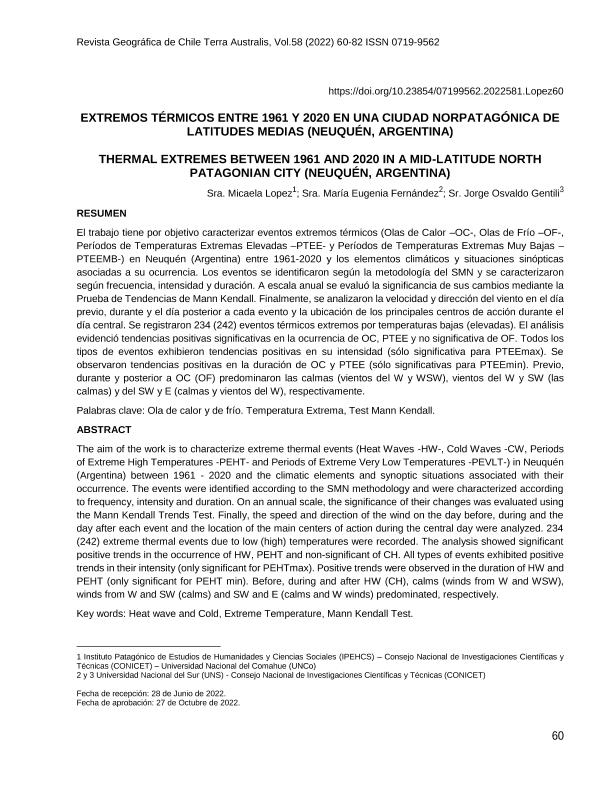Artículo
El trabajo tiene por objetivo caracterizar eventos extremos térmicos (Olas de Calor –OC-, Olas de Frío –OF-, Períodos de Temperaturas Extremas Elevadas –PTEE- y Períodos de Temperaturas Extremas Muy Bajas – PTEEMB-) en Neuquén (Argentina) entre 1961-2020 y los elementos climáticos y situaciones sinópticas asociadas a su ocurrencia. Los eventos se identificaron según la metodología del SMN y se caracterizaron según frecuencia, intensidad y duración. A escala anual se evaluó la significancia de sus cambios mediante la Prueba de Tendencias de Mann Kendall. Finalmente, se analizaron la velocidad y dirección del viento en el día previo, durante y el día posterior a cada evento y la ubicación de los principales centros de acción durante el día central. Se registraron 234 (242) eventos térmicos extremos por temperaturas bajas (elevadas). El análisis evidenció tendencias positivas significativas en la ocurrencia de OC, PTEE y no significativa de OF. Todos los tipos de eventos exhibieron tendencias positivas en su intensidad (sólo significativa para PTEEmax). Se observaron tendencias positivas en la duración de OC y PTEE (sólo significativas para PTEEmin). Previo, durante y posterior a OC (OF) predominaron las calmas (vientos del W y WSW), vientos del W y SW (las calmas) y del SW y E (calmas y vientos del W), respectivamente. The aim of the work is to characterize extreme thermal events (Heat Waves -HW-, Cold Waves -CW, Periods of Extreme High Temperatures -PEHT- and Periods of Extreme Very Low Temperatures -PEVLT-) in Neuquén (Argentina) between 1961 - 2020 and the climatic elements and synoptic situations associated with their occurrence. The events were identified according to the SMN methodology and were characterized according to frequency, intensity and duration. On an annual scale, the significance of their changes was evaluated using the Mann Kendall Trends Test. Finally, the speed and direction of the wind on the day before, during and the day after each event and the location of the main centers of action during the central day were analyzed. 234 (242) extreme thermal events due to low (high) temperatures were recorded. The analysis showed significant positive trends in the occurrence of HW, PEHT and non-significant of CH. All types of events exhibited positive trends in their intensity (only significant for PEHTmax). Positive trends were observed in the duration of HW and PEHT (only significant for PEHT min). Before, during and after HW (CH), calms (winds from W and WSW), winds from W and SW (calms) and SW and E (calms and W winds) predominated, respectively.
Extremos térmicos entre 1961 y 2020 en una ciudad norpatagónica de latitudes medias (Neuquén, Argentina)
Título:
Thermal extremes between 1961 and 2020 in a mid-latitude north patagonian city (Neuquén, Argentina)
Fecha de publicación:
12/2022
Editorial:
Universidad Bernardo O'Higgin. Instituto Geográfico Militar
Revista:
Revista Geografica de Chile Terra Australis
ISSN:
0378-8482
e-ISSN:
0719-9562
Idioma:
Español
Tipo de recurso:
Artículo publicado
Clasificación temática:
Resumen
Palabras clave:
EXTREME TEMPERATURE
,
HEAT WAVE AND COLD
,
MANN KENDALL TEST
Archivos asociados
Licencia
Identificadores
Colecciones
Articulos(CCT - BAHIA BLANCA)
Articulos de CTRO.CIENTIFICO TECNOL.CONICET - BAHIA BLANCA
Articulos de CTRO.CIENTIFICO TECNOL.CONICET - BAHIA BLANCA
Articulos(IPEHCS)
Articulos de INSTITUTO PATAGONICO DE ESTUDIOS DE HUMANIDADES Y CIENCIAS SOCIALES
Articulos de INSTITUTO PATAGONICO DE ESTUDIOS DE HUMANIDADES Y CIENCIAS SOCIALES
Citación
Lopez, Micaela; Fernández, María Eugenia; Gentili, Jorge Osvaldo; Extremos térmicos entre 1961 y 2020 en una ciudad norpatagónica de latitudes medias (Neuquén, Argentina); Universidad Bernardo O'Higgin. Instituto Geográfico Militar; Revista Geografica de Chile Terra Australis; 58; 12-2022; 60-82
Compartir
Altmétricas




